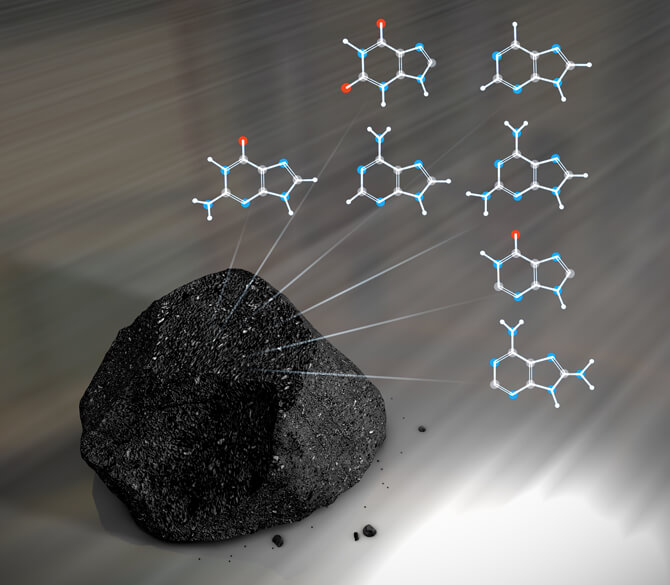New evidence for finding amino acids that are part of DNA in space

Researchers working in collaboration with NASA have obtained evidence that some of the building blocks of DNA, the molecule that stores the genetic instructions for life, originate from meteorites and that they were probably formed in space. The research provides support for the theory that a collection of ready-made components created in space and brought to Earth by meteorites and comets that collided with it helped the development of life on our planet.
"Researchers have been discovering DNA components in meteorites since the XNUMXs, but they weren't sure if these were formed in space or if they came from contamination from living things on Earth," said Dr. Michael Callahan, a NASA researcher. "For the first time ever, we have three pieces of evidence which in combination give us confidence that these building blocks of DNA were indeed created in space." The research findings were published in the scientific journal Proceedings of the National Academy of Sciences.
The discovery adds a layer to the growing series of evidence that the chemistry inside asteroids and comets is capable of producing building blocks of vital biological molecules. For example, in the past these scientists found amino acids in samples from a comet named Wild 2 and several high-carbon meteorites. Amino acids are used to make proteins, the molecules essential to life that are used in everything from structures such as hair to enzymes, the catalysts that speed up or regulate chemical reactions in the body.
In the new study, the team of scientists collected samples from twelve high-carbon meteorites, nine of which were found in Antarctica. The researchers extracted each of the samples with a solution of formic acid and tested them using liquid chromatography, a chemical method used to separate a mixture of compounds. In the next step, they examined the samples using a mass spectrometer that helps determine the chemical structure of the separate compounds.
The researchers found in these samples adenine and guanine, which are components of DNA called nucleotide bases, as well as the compounds hypoxanthine and xanthine. DNA is a spiral ladder-like structure - adenine and guanine bind to two other nucleotide bases to form the rungs of the spiral ladder. They are part of the genetic code that controls the cellular mechanism controlled by the proteins. Hypoxanthine and xanthine are not found in DNA, but are essential in other biological processes.
In addition, the team discovered in two of the meteorites, for the first time ever, small amounts of three molecules related to nucleotide bases: purine, 2,6-diaminopurine and 6,8-diaminopurine; The last two almost never appear in biological systems. These compounds contain the same structural skeleton as nucleotide bases, but they have a slightly different structure.
These molecules, which are related to nucleotide bases and which are called analogues of nucleotide bases, provide the first part of the evidence that the compounds in meteorites came from space and not from earthly impurities.
"You would not expect to discover these analogs if their source is terrestrial infections, since they are not used in biological systems," explains the lead researcher. "On the other hand, if asteroids act as chemical "factories" for the production of pre-life substances, you would indeed expect that they would produce different forms of nucleotide bases, and not just the biological forms, due to the variety of starting materials and the different conditions existing in the asteroid."
The team also examined an eight-kilogram sample of ice from Antarctica, where most of the study's meteorites were found, using the same chemical methods as when testing the meteorites. The amounts of the two nucleotide bases, and of the compounds xanthine and hypoxanthine, found in ice, were much smaller than in meteorites. More importantly, none of the analogues of the nucleotide bases were found in the ice sample. One of the meteorites that contained analogous molecules of nucleotide bases came from Australia, and the team also examined a soil sample collected near the impact site. Just as it was for the ice sample, the soil sample did not contain any of the analogous molecules of the nucleotide bases found in the meteorite. These findings constitute the second part of the support for the researchers' theory.
The third piece of evidence for the theory comes from the researchers' success in producing these nucleotide bases – both biological and non-biological – through a completely non-biological reaction. "In the laboratory, we were able to produce the same molecules through non-biological chemical reactions from the reactants hydrogen cyanide, ammonia and water. These findings provide a plausible mechanism for their synthesis in asteroids and support the theory that they originate outside the Earth," explains the researcher.

5 תגובות
This reinforces the assumption that life did not originate on Earth but came to it from outer space
Yes, there is a mistake in the subtitle "New evidence for finding amino acids that are part of DNA in space"
Amino acids are not part of DNA - which is the name of a molecule (deoxy (ribo) nucleic acid). should be nucleic acids.
DNA polymerase:
If they wrote that the building blocks of DNA are amino acids - there would really be a mistake here, but they didn't write it, so the mistake is in your response.
I always thought about the idea that the whole universe is just a small cell in a huge body of a being that lives on a planet with millions of other beings like it and they are all inside a planet that is part of a galaxy that is just a small cell in a huge body with millions more like it…..
It seems to me that there was a small mistake here - amino acids are the building blocks of proteins and not of DNA...